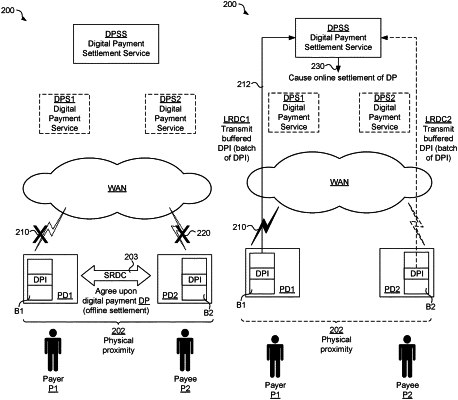| CPC G06Q 20/3278 (2013.01) [G06Q 20/108 (2013.01); G06Q 20/3678 (2013.01); G06Q 20/3823 (2013.01); G06Q 20/389 (2013.01); G06Q 20/401 (2013.01); H04L 9/0825 (2013.01); H04L 9/3247 (2013.01); H04L 9/3263 (2013.01)] | 25 Claims |

|
1. A method for handling a digital payment between a payer and a payee, the method comprising:
a payer communication device, used by the payer, and a payee communication device, used by the payee, using short-range data communication when the devices are in proximity of each other to agree upon a digital payment without requiring long-range data communication with a remote digital payment settlement service at that stage;
the payer communication device and the payee communication device both buffering digital payment information pertaining to the digital payment locally in the respective device;
independently of the other device, the payer communication device or the payee communication device subsequently communicating the buffered digital payment information to the remote digital payment settlement service by long-range data communication; and
the remote digital payment settlement service causing settlement of the digital payment as indicated by the digital payment information received by long-range data communication from one of the payer communication device and the payee communication device without having to wait for the digital payment information to be received from the other one of the payer communication device and the payee communication device,
wherein the payer communication device and the payee communication device agree upon the digital payment by:
the payee communication device transmitting payment details for the digital payment to the payer communication device by short-range data communication,
the payer communication device using the payment details and a digital signature of the payer to digitally sign the digital payment and generate a payment token,
the payer communication device transmitting the payment token to the payee communication device by short-range data communication, and
the payee communication device buffering the received payment token in or as said digital payment information locally in the payee communication device,
wherein the payer communication device comprises a secure element, the secure element storing a private cryptographic key of the payer communication device or payer, the payer communication device using the secure element to digitally sign the digital payment by the private cryptographic key and generate the payment token, and
wherein the payee communication device uses a public cryptographic key associated with the private cryptographic key of the payer communication device or payer to verify the received payment token as a requisite for accepting the digital payment.
|